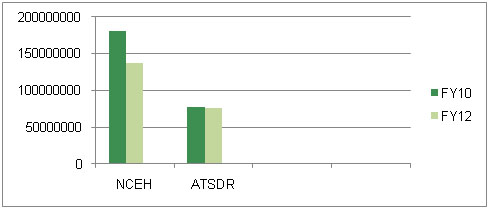2012 Budget Information
Overview

This year the United States faces a challenging budget climate. Aligning the federal budget with the nation’s priorities requires attention to high priority areas and calls for changes in the way we operate. In 2012, some of those changes are expected to affect the way CDC’s National Center for Environmental Health (NCEH) and the Agency for Toxic Substances and Disease Registry (ATSDR) provide services to states and other groups. NCEH/ATSDR will work closely with its partners to address challenges presented by the new financial realities.
For Fiscal Year 2012 (FY12), 30% less funding has been requested for NCEH than what the center received in FY2010 (FY10). This is a reduction of about $43.3 million from FY10. The FY12 request for ATSDR marks a decrease of $455,000 (0.6%) from the FY10 funding level.

FY12 Budget Changes for Environmental Public Health
ATSDR
The major change from FY10 is that the FY 12 request for ATSDR does not include a one-time appropriation of $23 million that was made in FY10. This funding, from the Affordable Care Act, remains available through FY14 to conduct medical monitoring of persons who now live or who once lived in communities declared a public health emergency. The appropriation is being used to support screening and educational activities related to asbestos exposure in Libby, MT. ATSDR will absorb the proposed $455,000 reduction through administrative savings.
NCEH
New Program: Healthy Home and Community Environments NCEH is developing a new program called Healthy Home and Community Environments. This program will combine CDC’s National Asthma Control Program (NACP) and its Healthy Homes/Lead Poisoning Prevention Program (HH/LPPP). Integrating these programs will realize savings by streamlining management. The process will take about two years, and with the proposed reduction in funding, CDC also expects a reduction in funding to states.
The Healthy Home and Community Environments program will be funded at $32.6 million, a $33 million (51%) decrease from the FY10 appropriations for NACP and HH/LPPP. These necessary reductions in funding will bring changes for state and local health departments and the people they serve. Because CDC funds state and local health departments to provide these services, the funding cut may reduce about 225 state and local public health jobs.
The 36 NACP-funded states and territories are home to 5.3 million children younger than age 18 living with asthma. These states have implemented comprehensive asthma control programs that realized a 10% decline in asthma-related hospitalizations between 2000 and 2007, resulting in about $23 million reduction in hospitalization costs. Additionally, mortality rates for asthma declined 30% from 1999 to 2006, resulting in a near $1.5 billion reduction in productivity losses due to mortality. Under the FY12 budget, the number of states funded could drop to 15 or fewer. CDC will work to expand coverage for asthma treatment through the Affordable Care Act.
In the 35 states receiving funding from the HH/LPPP for lead poisoning prevention, about 200,000 children under 6 years of age have blood lead levels greater than 10 mg/dL. A recent cost–benefit analysis suggests that every dollar spent to reduce lead hazards achieves a benefit of $17–220. This ratio is better than that for vaccines, which have long been described as the single most cost-beneficial medical or public health intervention (Gould, 2009, Environmental Health Perspectives 117:1162-1167). The total number of federal HH/LPP funds recipients could decline from 46 to 34. These recipients will develop Healthy Homes programs integrating several home-based environmental interventions, including both asthma and lead poisoning prevention.
Other Program Changes
Several NCEH programs are funded in a budget category called “Environmental Health Activities.” The FY12 budget request of $61.6 million includes $9 million from the Affordable Care Act Prevention and Public Health Fund. This request is $10.25 million (14.3%) below the FY10 level. As a result of this change, NCEH will be reducing several programs.
Programs to be Reduced
Basic Environmental Health and Radiation Preparedness: Reductions in funding of $3.6 million could limit CDC’s ability to provide capacity, training and research to ensure state and local health departments can maintain strong core environmental health services (e.g. restaurant and septic inspections, and vector control). It could also affect CDC’s ability to respond to radiological events or disasters, provide environmental epidemiologic expertise to state and international agencies, and work with communities affected by radiation.
Climate Change: This program that supports 8 state and 2 local health departments in planning and preparing for the health impacts of climate change will be reduced by $972,000 (13.8%).
Environmental Health Tracking: The FY12 budget request is $32 million. This reflects a $10 million decrease from the FY10 level; however, $9 million is being transferred from the Affordable Care Prevention and Public Health Fund in FY12. The Tracking Program captures accurate exposure and outcome data which public health departments and others use to develop public health efforts to prevent harmful environmental exposures.
Healthy Community Design: CDC aims to fund community-based built environment activities with funds from Community Transformation Grants. Community design has been shown to have a direct effect on residents’ health. For example, the design of community environments is linked to major public health outcomes such as motor vehicle injuries, physical activity, and respiratory disease. The proposed $2.6 million budget reduction could eliminate the Healthy Community Design Initiative within NCEH. For the past decade NCEH has influenced the integration of public health into community and transportation design decisions.
Safe Water/Foodborne and Waterborne Illnesses: Clean drinking water and improved sanitation are considered highly effective public health interventions. Acute foodborne illnesses cost the United States $152 billion per year in healthcare, workplace and other economic losses. Waterborne illnesses cost the United States $154-539 million dollars a year in hospitalization costs alone. This is the only CDC program to support directly state and local public health departments for environmental water-related activities.
Programs Continuing
Environmental Health Laboratory: The FY12 request of $43.4 million for the Environmental Health Laboratory is $6,000 above the FY10 level. The increase will support more development and application of advanced laboratory technology to improve the diagnosis, treatment, and prevention of disease resulting from exposure to toxic substances. The Environmental Health Laboratory assesses population exposure to environmental chemicals, provides quality assurance and standardization for laboratory programs, improves and develops laboratory methods to diagnose and prevent disease, contributes to studies of populations exposed to environmental chemicals, and assists states with newborn screening.
- Page last reviewed: February 14, 2011
- Page last updated: February 14, 2011
- Content source:



 ShareCompartir
ShareCompartir